Excellent content marketing is hard to nail down. According to a recent survey, a massive 72% of marketing professionals today describe their content marketing campaigns as falling between flat-out ineffective and only mildly effective.
Also, in the last ten years, content marketing has grown and changed drastically. Content comes in many shapes and forms, with a lot of channels to distribute it.
Taking this into account, we have gathered, evaluated, and organized the latest statistics to help you get the results you seek. So keep reading to find the most fascinating content marketing statistics you must be aware of.
Content marketing usage statistics
82% of marketers are actively investing in content marketing, 10% report not using content marketing, and 8% are unsure if their company uses content marketing. (2021)
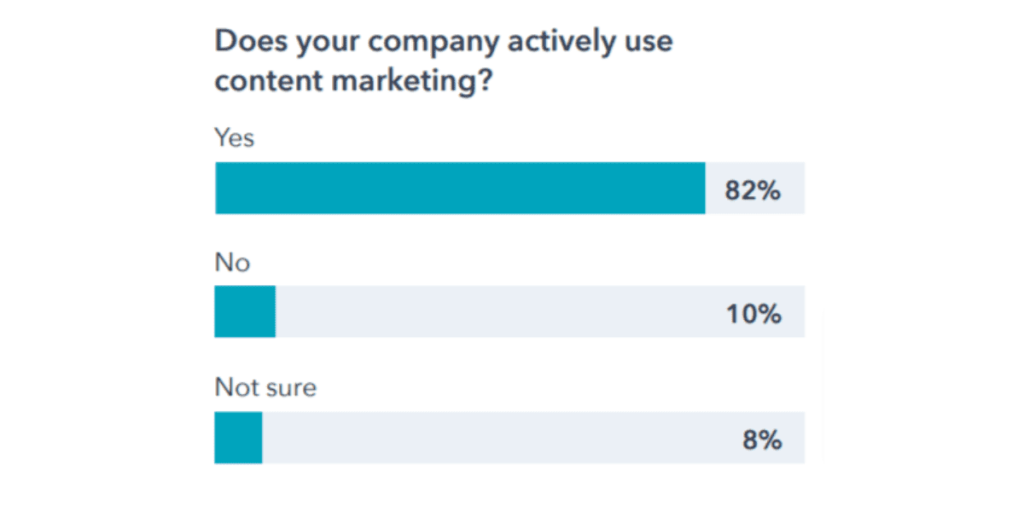
Image Source: Hubspot
60% of marketers report that content marketing generates demand/leads. In addition, 70% of marketers say that content marketing helps to educate the audience, and 60% say that it helps build loyalty with existing clients/customers. (2021)
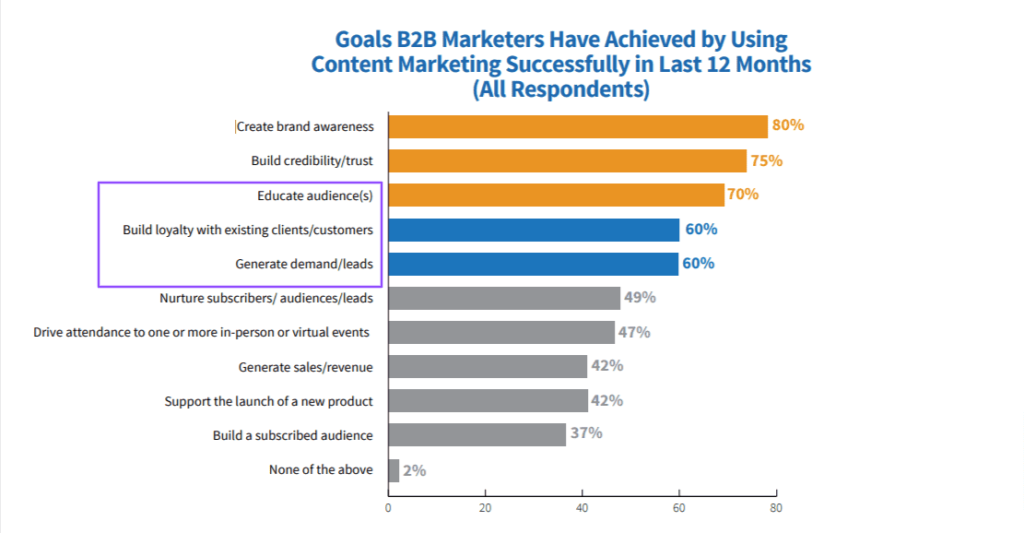
Image Source: CMI
81% of marketers view content as a core business strategy (2021).

Image Source: CMI
About 66% of marketers expected to increase their content marketing budget in 2022. (2022)
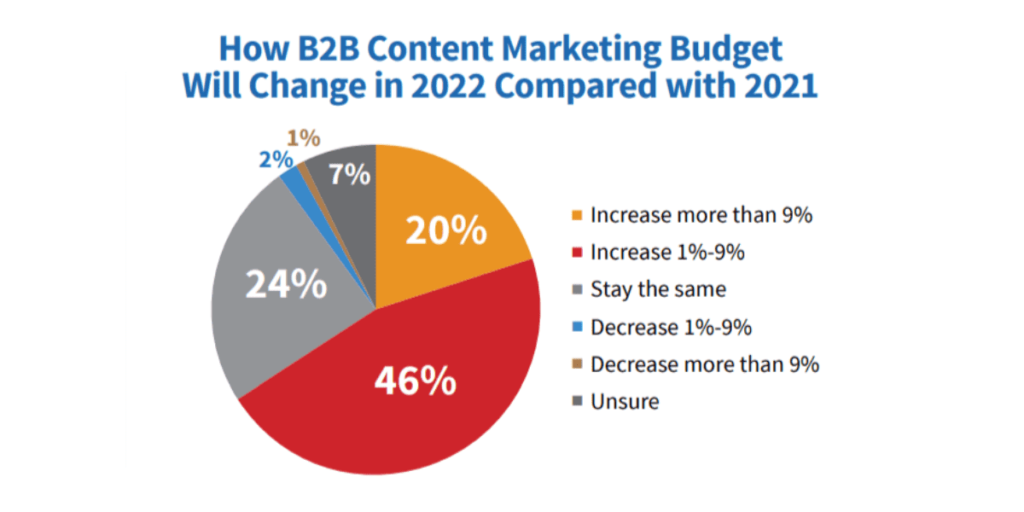
Image Source: CMI
59% of companies reported having 1-5 employees dedicated to content marketing. Only 32% of B2B marketers said they didn’t have even one. (2022)
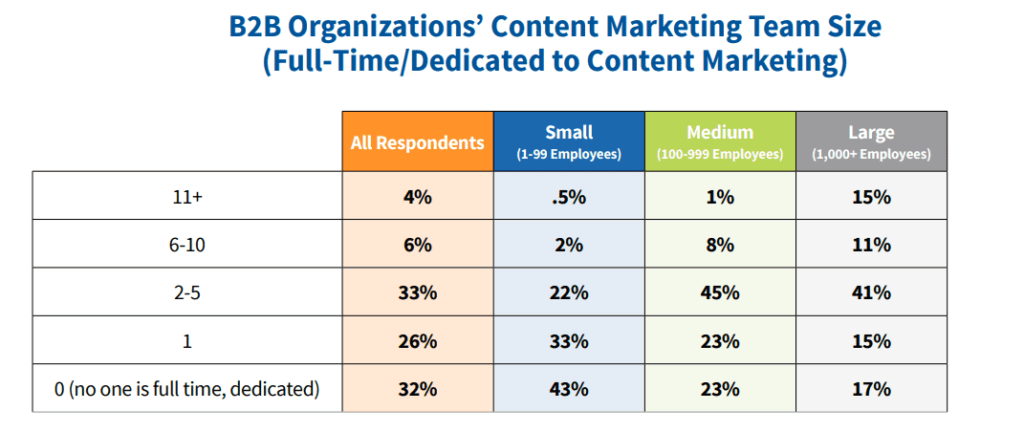
Image Source: CMI
Content marketing strategy statistics
Only 5% of B2B marketers don’t plan to develop a content marketing strategy (2022).
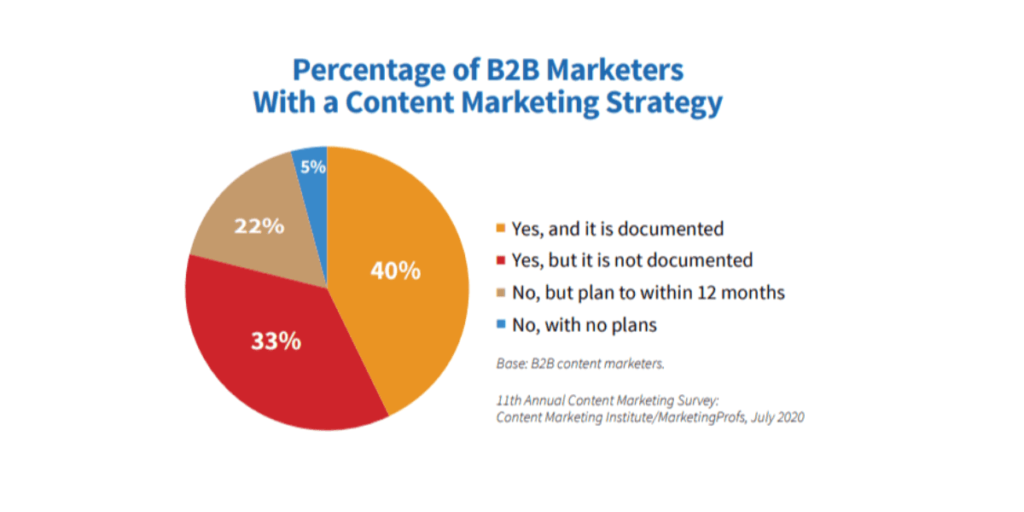
Image Source: CMI
The top three primary goals of creating content are boosting sales, building relationships with customers, and increasing brand awareness (2021).
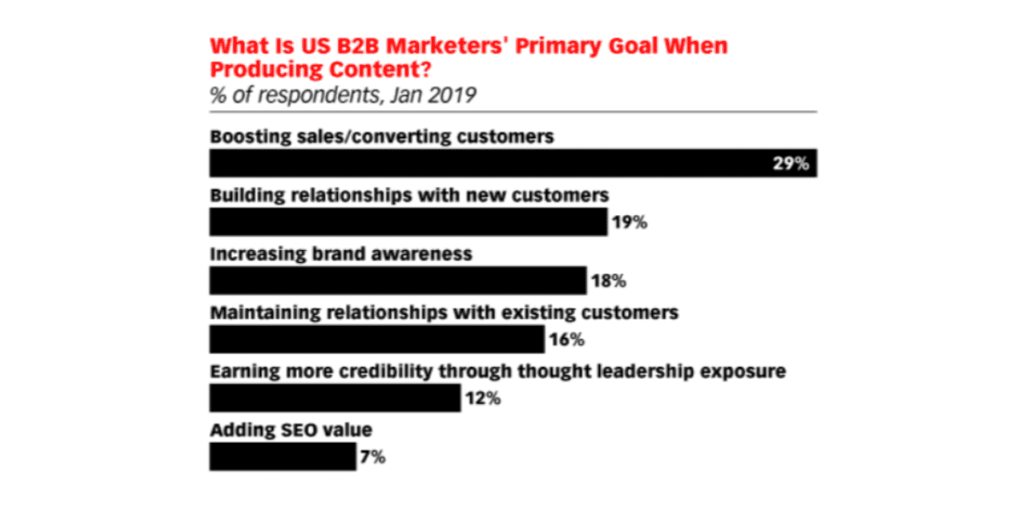
Image Source: eMarketer
51% of the businesses that invest in content marketing publish content every day (The Manifest).

Image Source: The Manifest
The five most common content marketing challenges in 2021: creating content that appeals to multi-level roles within a target audience (44%), accessing subject matter experts to create content (42%), internal communication between teams/silos (38%), creating valuable content instead of sales-oriented messaging (36%), and differentiating our products/services from competitors (35%). (B2B Content Marketing 2022 Report)
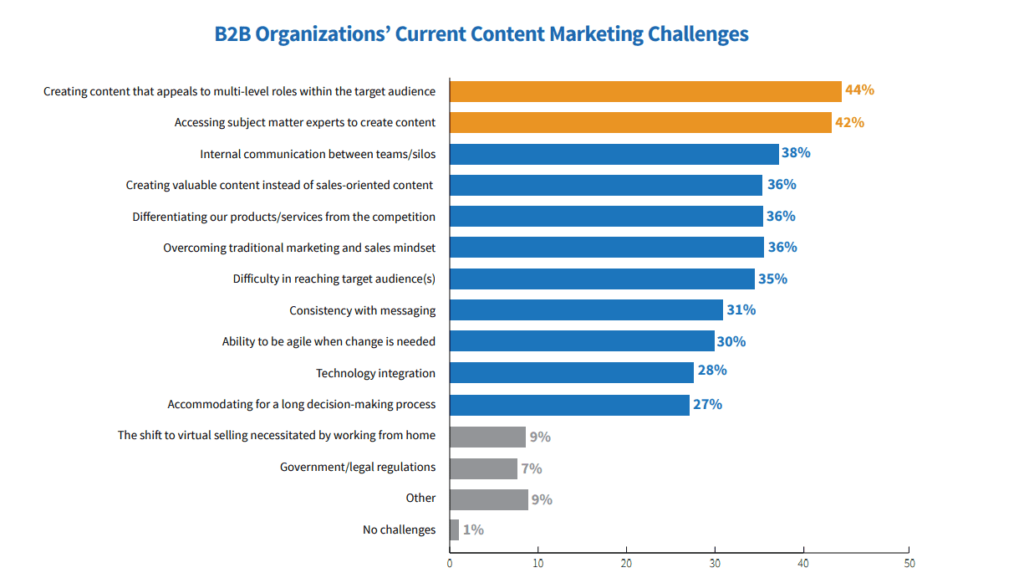
Image Source: CMI
Only 40% of B2B organizations reported having a documented content marketing strategy. That number jumps to 62% among the most successful content marketers. (B2B Content Marketing 2022 Report)

Image Source: CMI
The top five areas of investment for 2022: video (69%), events (digital, in-person, hybrid) (61%), owned-media assets (57%), paid media (55%), social media management/community building (39%). (B2B Content Marketing 2022 Report)

Image Source: CMI
The five most common content marketing goals in 2021: creating brand awareness (80%), building credibility/trust (75%), educating audiences (70%), building loyalty with existing customers/clients (60%), and generating demand/leads (60%). (B2B Content Marketing 2022 Report)

Image Source: CMI
On average, content marketers reported that 69% of the content they create is for the top of the funnel. Only 43% of the content they create is for the middle of the funnel, 20% for the bottom, and 18% for retention. (The State of Content Marketing 2020 by SEMrush)

Image Source: SEMrush
Content marketing ROI statistics
72% of the most successful marketers in North America measure the ROI of their content marketing (eMarketer).
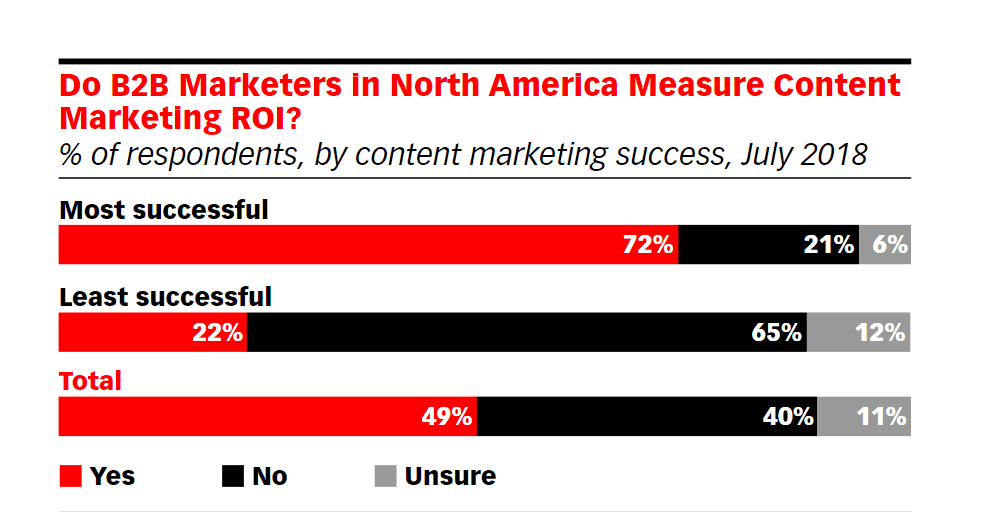
Image Source: eMarketer
Of marketers surveyed, 83% measure the success of their content based on website engagement (69%), conversions (67%), website traffic (65%), email engagement (64%), or social media analytics (51%). (B2B Content Marketing 2022 Report).

Image Source: CMI
In the past 12 months, most B2B marketers reported content marketing being most effective in creating brand awareness (80%), building credibility/trust (75%), and educating audiences (70%). (B2B Content Marketing 2022 Report)
60% of marketers report that content marketing generates demand/leads. In addition, 70% of marketers say that content marketing helps to educate the audience, and 60% say that it helps build loyalty with existing clients/customers (CMI).
Image Source: CMI
Content distribution statistics
76% of B2B marketers reported increasing (45%) or maintaining (31%) their paid content distribution investment in the past 12 months. (B2B Content Marketing 2022 Report)

Image Source: CMI
Social media remains the most popular with 77% of content marketers using paid distribution on various platforms as part of their content strategy. (B2B Content Marketing 2022 Report)
The most popular unpaid content distribution channels that content marketers used in 2021 were: media/public relations (52%), speaking/presenting at events (52%), guest posts/articles in third-party publications (43%), collaborative social spaces (33%), and guest spots (32%). (B2B Content Marketing 2022 Report)
The top five B2B organic (non-paid) social media platforms that produced the best results in the last 12 months: LinkedIn (77%), Facebook (37%), Instagram (27%), YouTube (21%), and Twitter (17%). (B2B Content Marketing 2022 Report)
More than half (58%) of B2B content marketers said virtual events/webinars/online courses produced the best results for their content marketing in the last 12 months. Those who are most successful agreed (66%). (B2B Content Marketing 2022 Report)
LinkedIn is the social media platform most frequently used for B2B content distribution (75%), followed by Facebook (69%) and Instagram (30%). (B2B Content Marketing 2022 Report)
Furthermore, LinkedIn is the platform where B2B buyers are most likely to share professional content. (Demand Gen Report 2021 Content Preferences Survey Report)

Image Source: Demand Gen
LinkedIn is used by 96% of B2B content marketers (CMI).
The top three organic content distribution channels used by B2C marketers are social media, email, and their organization’s blog/website (CMI).
B2C marketers who use at least two organic social media platforms report that Facebook (59%) and Instagram (21%) produce the best overall content marketing results (CMI).
Only 28% of B2B marketers don’t use paid content distribution channels (CMI).
Only 28% of B2C marketers don’t use paid content distribution channels (CMI).
82% of marketers reported that video has become more important than ever as a medium. (State of Video 2022 by Vidyard)

Image Source: Vidyard
YouTube remains the most widely used video platform for content marketers, with 88% of video marketers planning to use it in 2022. (State of Video Marketing 2022 by Wyzowl)
The number of marketers using TikTok as a marketing tool has increased 13% from last year to 33%. (State of Video Marketing 2022 by Wyzowl)
Podcast ad spending in the U.S. is expected to reach $2.2B in 2023, a 27% increase from 2022. (Statista)

Image Source: Statista
B2B content marketing statistics
Only 4% of B2B marketers don’t plan to develop a content marketing strategy (CMI).
87% of B2B marketers prioritize the audience’s informational needs over the organization’s sales/promotional messages (CMI).
Content creation is the most outsourced content marketing activity among B2B marketers (CMI).
The top three organic content distribution channels used by B2B marketers are social media, email, and their organization’s blog/website (CMI).
78% of B2B marketers employ keyword research for SEO while creating content (CMI).
Only 28% of B2B marketers don’t use paid content distribution channels (CMI).
LinkedIn is used by 96% of B2B content marketers (CMI).
LinkedIn is the social media platform most frequently used for B2B content distribution (75%), followed by Facebook (69%) and Instagram (30%). (B2B Content Marketing 2022 Report)
Only 40% of B2B organizations reported having a documented content marketing strategy. That number jumps to 62% among the most successful content marketers. (B2B Content Marketing 2022 Report)
About 50% of all B2B marketers said they outsource content marketing activities, and 65% said their biggest challenge is finding partners with adequate subject matter expertise. (B2B Content Marketing 2022 Report)
The top five B2B organic (non-paid) social media platforms that produced the best results in the last 12 months: LinkedIn (77%), Facebook (37%), Instagram (27%), YouTube (21%), and Twitter (17%). (B2B Content Marketing 2022 Report)
More than half (58%) of B2B content marketers said virtual events/webinars/online courses produced the best results for their content marketing in the last 12 months. Those who are most successful agreed (66%). (B2B Content Marketing 2022 Report)
B2C content marketing statistics
Let’s see how answers given by B2C content marketers compare to their B2B counterparts.
Only 6% of B2C marketers don’t plan to develop a content marketing strategy (CMI).
The top three organic content distribution channels used by B2C marketers are social media, email, and their organization’s blog/website (CMI).
Content creation is the most outsourced content marketing activity among B2C marketers (CMI).
The top three most often used content formats by B2C marketers are blog posts/short articles, email newsletters, and videos (CMI).
B2C marketers who use at least two organic social media platforms report that Facebook (59%) and Instagram (21%) produce the best overall content marketing results (CMI).
Only 28% of B2C marketers don’t use paid content distribution channels (CMI).
73% of B2C marketers employ keyword research for SEO while creating content (CMI).
Organic search statistics
68% of online experiences begin with a search engine (Brightedge).
53% of shoppers say they always do research before a purchase to ensure they are making the best possible choice (Google).
Almost two-thirds of global online search comes from mobile devices (Perficient).
In 2020, 75% of content marketers reported that organic search (aka SEO) was the most effective content marketing tactic they implemented during the year. That was followed by updating and repurposing existing content, a strategy used by 61% of respondents. (The State of Content Marketing 2020 by SEMrush)
69% of marketers actively invest in SEO (HubSpot).
71% of marketers say that targeting strategic keywords is their top SEO tactic (HubSpot).
The top three most often used metrics for SEO are keyword ranking, organic traffic, and time spent on page (HubSpot).
90.63% of pages get no organic search traffic from Google. (Ahrefs)
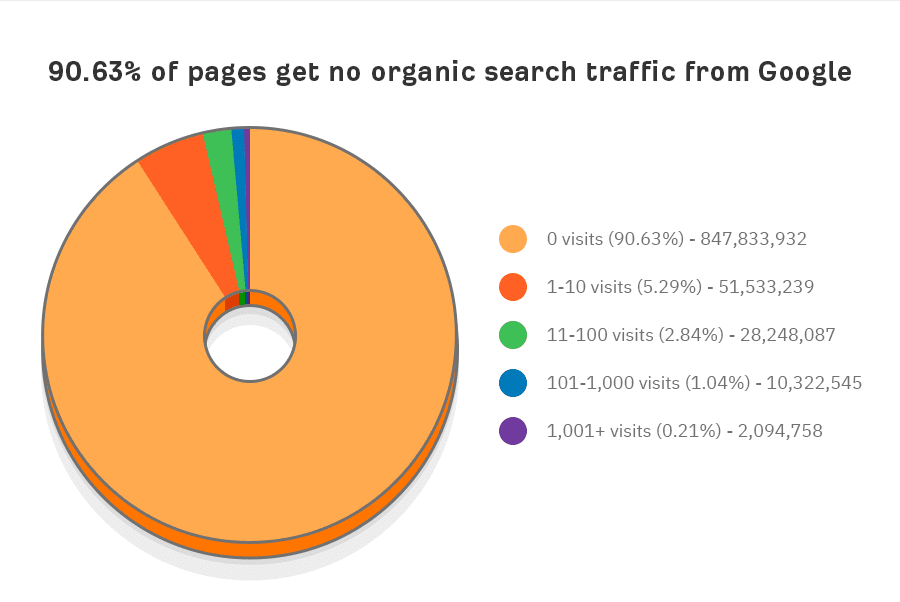
Image Source: Ahrefs
Generally speaking, the more backlinks a page has, the more organic traffic it gets from Google (Ahrefs).
The average #1 ranking page will also rank in the top 10 for nearly 1,000 other relevant keywords. (Ahrefs)

Image Source: Ahrefs
There’s no correlation between Flesch Reading Ease scores and ranking positions. (Ahrefs)

Image Source: Ahrefs
78% of B2B marketers employ keyword research for SEO while creating content (CMI).
73% of B2C marketers employ keyword research for SEO while creating content (CMI).
Business Blogging statistics
People rarely read online. They’re far more likely to scan than read word for word. They simply want to pick out the information that is most pertinent to their current needs (Nielsen).
To date, there are more than 600 million blogs out of 1.9 billion websites in the world. Their authors account for over 6 million blog posts daily, or over 2.5 billion annually (hosting tribunal).
How-to articles are the most popular content formats (77%), followed by news and trends (49%), and guides and ebooks (47%) (Statista).
Only one-third of bloggers regularly check their blogs’ traffic analytics (Statista).
Long articles/posts stood out as an area where those who are most successful reported better results than respondents overall (43% vs. 32%). (B2B Content Marketing 2022 Report)
Long reads of 3000+ words get 138% more traffic than those with fewer than 500. (The State of Content Marketing 2022 by SEMrush)
78% of articles with fewer than 500 words haven’t been shared, period.
Articles with seven or fewer words in their H1 average 36% more organic traffic than those with 14 or more words. (The State of Content Marketing 2022 by SEMrush)
Video usage statistics
YouTube is the second-most visited website in the U.S. by organic traffic (Ahrefs).
YouTube reaches more 18- to 49-year-olds in an average week than all cable TV networks combined (Google).
70% of viewers bought from a brand after seeing it on YouTube (Google).
Video viewers say relating to their passions is 3X more important than content featuring famous actors (Google).
Video viewers say relating to their passions is 1.6X more important than content with high production quality (Google).
A business’ website and social media tied as the most popular places to use video. (State of Video 2022 by Vidyard)
79% of people say they’ve been convinced to buy or download a piece of software or app by watching a video (Wyzowl).
That number jumps to 96% when asked if a video convinced them to buy a product or service. (State of Video Marketing 2021 by Wyzowl)
96% of people have watched an explainer video to learn more about a product or service (Wyzowl).
85% of people want to see more videos from brands in 2021 (Wyzowl).
69% of respondents prefer to learn about a product or service from a short video. 18% prefer to read a text-based article, website, or post. 4% prefer to view an infographic. 3% prefer to download an ebook or manual. 3% prefer to attend a webinar or pitch. 2% prefer to receive a sales call or demo (Wyzowl).
Articles with videos get 83% more traffic than those without. In fact, articles with more than three videos generated 55% more backlinks than those with none. (The State of Content Marketing 2022 by SEMrush)
Video marketing statistics
As reported by Hubspot, video is the primary form of marketing media being created in 2021. It seems that video marketing is no longer an option.
In 2022, 86% of businesses use video as a marketing tool. (State of Video Marketing 2021 by Wyzowl) This number was consistent in 2021 but has grown from 85% in 2020, 81% in 2018, 63% in 2017, and 61% in 2016.
YouTube remains the most widely used video platform for content marketers, with 88% of video marketers planning to use it in 2022. (State of Video Marketing 2022 by Wyzowl)
The number of marketers using TikTok as a marketing tool has increased 13% from last year to 33%. (State of Video Marketing 2022 by Wyzowl)
A whopping 92% of marketers who use video say that it’s an important part of their content marketing strategy. (State of Video Marketing 2022 by Wyzowl)
An overwhelming 92% of video marketers feel the level of noise and competition has increased in the last year. (State of Video Marketing 2021 by Wyzowl)
91% of marketers feel the pandemic has made video more important for brands (Wyzowl).
46% of marketers say video has become easier to create in-house. (State of Video Marketing 2022 by Wyzowl)
86% say video has helped them generate leads. (State of Video Marketing 2022 by Wyzowl)
49% of video marketers say video has reduced the number of support calls they’ve received – up 6% from last year. (State of Video Marketing 2022 by Wyzowl)
94% say video has helped increase user understanding of their product or service. (State of Video Marketing 2022 by Wyzowl)
81% of video marketers say video has directly helped increase sales, and 87% of video marketers say video gives them a good return on their investment. (State of Video Marketing 2021 by Wyzowl)
About 91% of marketers say their webinars have been a success, making it the most effective video marketing channel, according to State of Video Marketing 2021 by Wyzowl.
82% of marketers reported that video has become more important than ever as a medium. (State of Video 2022 by Vidyard)
93% of content marketers believe that video converts the same or better than other forms of content. (State of Video 2022 by Vidyard)
About 74% of B2B consumers are only willing to spend 10 minutes or less watching video content, while 44% won’t spend more than 5 minutes. (Demand Gen Report 2020 Content Preferences Survey Report)
About 35% are willing to watch 30-60 minutes if it is a webinar. (Demand Gen Report 2020 Content Preferences Survey Report)
50.9% of B2B decision-makers use YouTube to research purchases (Hootsuite).
51% of B2B marketers reported webinars/webcasts/web series delivering the best results for them in the past 12 months. (B2B Content Marketing 2022 Report)
Podcast statistics
Podcast ad spending in the U.S. is expected to reach $1.74B in 2022, a 23% increase from 2021 (Statista).
57% of Americans listen to podcasts (Edison Research).
Weekly podcast listeners tune in to an average of eight podcasts per week (Edison Research).
Each week in America, there are more podcast listeners than Netflix account holders (Edison Research).
80% of podcast listeners listen to all or most of each episode (Podcast Insights).
Visual marketing statistics
The majority of marketers surveyed say that visual content is a key component of their marketing strategy. 64% say that visuals are either essential or very important. Only 9.6% don’t require visuals for their content marketing (Venngage).
Posts with more than seven images get 116% more organic traffic than articles containing just text. (The State of Content Marketing 2022 by SEMrush)
Audience behavior and preferences statistics
55% of respondents said they relied even more on content to research and inform purchase decisions than they did in 2021. (Demand Gen Report 2022 Content Preferences Survey Report)
A majority of B2B buyers (62%) said they engage with 3-7 pieces of content before connecting with a salesperson, and 11% said they typically consume more than seven pieces of content. (Demand Gen Report 2022 Content Preferences Survey Report)
51% of B2B buyers reported that “using data and research to support claims” made content more memorable and more likely to trigger a sales call for them. (Demand Gen Report 2022 Content Preferences Survey Report)
39% of B2B buyers reported that B2B vendors could improve their content by curbing sales messages. (Demand Gen Report 2022 Content Preferences Survey Report)
37% of B2B buyers reported that B2B vendors could improve their effectiveness by creating shorter content. (Demand Gen Report 2022 Content Preferences Survey Report)
41% of B2B buyers reported putting more emphasis on the trustworthiness of the source of content. (Demand Gen Report 2022 Content Preferences Survey Report)
About 43% of people said they find research/survey reports to be most valuable when researching B2B purchases. (Demand Gen Report 2022 Content Preferences Survey Report)
52% of B2B buyers report that they would like to see content organized by topic according to issue/pain point, 51% by topics, 46% by industry/vertical, and 42% by business role. (Demand Gen Report 2022 Content Preferences Survey Report)
In the early stages of their buyer’s journeys, 81% of B2B buyers report enjoying listicles, 72% infographics, 66% blogs, and 62% videos. (Demand Gen Report 2021 Content Preferences Survey Report)
In the mid-stage of their buying journey, 50% want to see assessments, 49% research and reports, and 46% case studies. (Demand Gen Report 2021 Content Preferences Survey Report)
Case studies (35%), third-party reports (31%), and assessments (18%) are preferred in the late stages. (Demand Gen Report 2021 Content Preferences Survey Report)
About 74% of B2B consumers are only willing to spend 10 minutes or less watching video content, while 44% won’t spend more than 5 minutes. (Demand Gen Report 2020 Content Preferences Survey Report)
People are twice as likely to share video content with their friends than any other type of content, including social media posts, blog posts, and product pages. (State of Video Marketing 2022 by Wyzowl)
When asked how they’d most like to learn about a product or service, 73% of respondents said they’d prefer to watch a short video than read a blog post, view an infographic, or watch a webinar, among other things. (State of Video Marketing 2022 by Wyzowl)
85% of people want to see more videos from brands in 2021 (Wyzowl).
Video viewers say relating to their passions is 3X more important than content featuring famous actors (Google).
Video viewers say relating to their passions is 1.6X more important than content with high production quality (Google).
53% of shoppers say they always do research before a purchase to ensure they are making the best possible choice (Google).
People rarely read online. They’re far more likely to scan than read word for word. They simply want to pick out the information that is most pertinent to their current needs (Nielsen).
Final thoughts on state of content marketing
Content marketing is more important than ever before. So we hope you’ve found valuable insight in the above collection of statistics. After all, it’s always a good idea to look for data-driven answers to your marketing hypotheses.
Use the statistics above to inform and guide some game-changing content marketing experiments. But let’s remember that it’s wise to take any statistic with a grain of salt.
Statistics are generalizations of only a portion of the reality around us. Also, they aren’t methodologically sound all of the time: small sample sizes, p-hacking, and spurious correlations are quite common.
So if you’ve just read a piece of data that contradicts your professional marketing experience, don’t throw away your content strategy just yet. Instead, dig deeper.
Did we miss anything? Did you act on these trends? Do you have any questions or comments? Share your thoughts below in the comments section.


